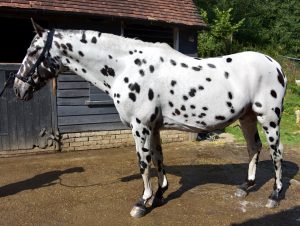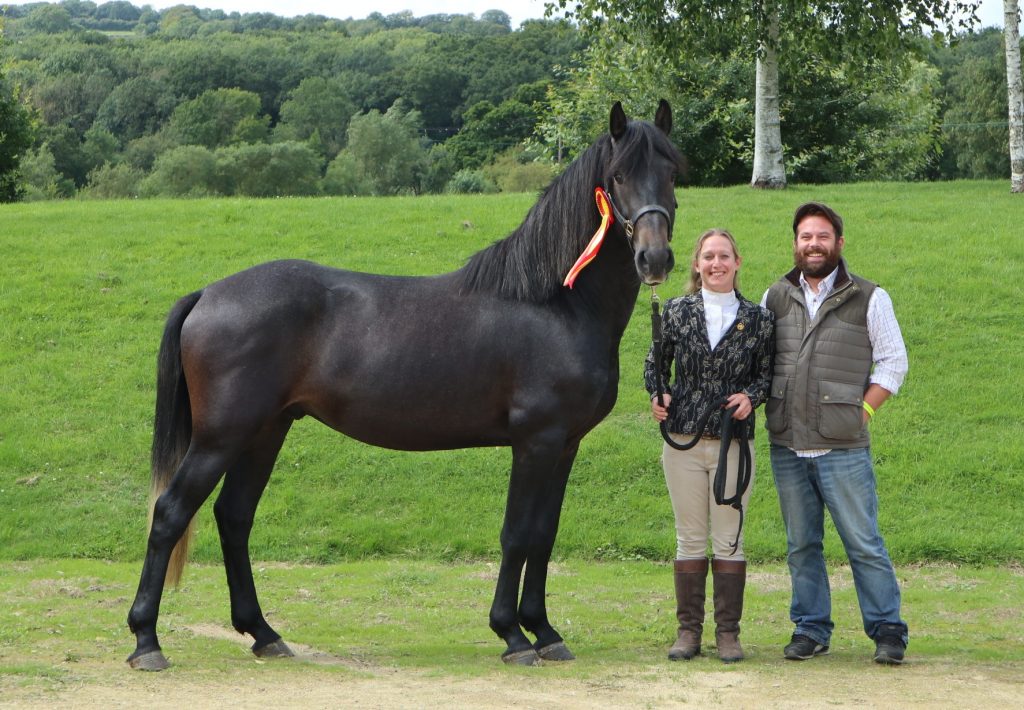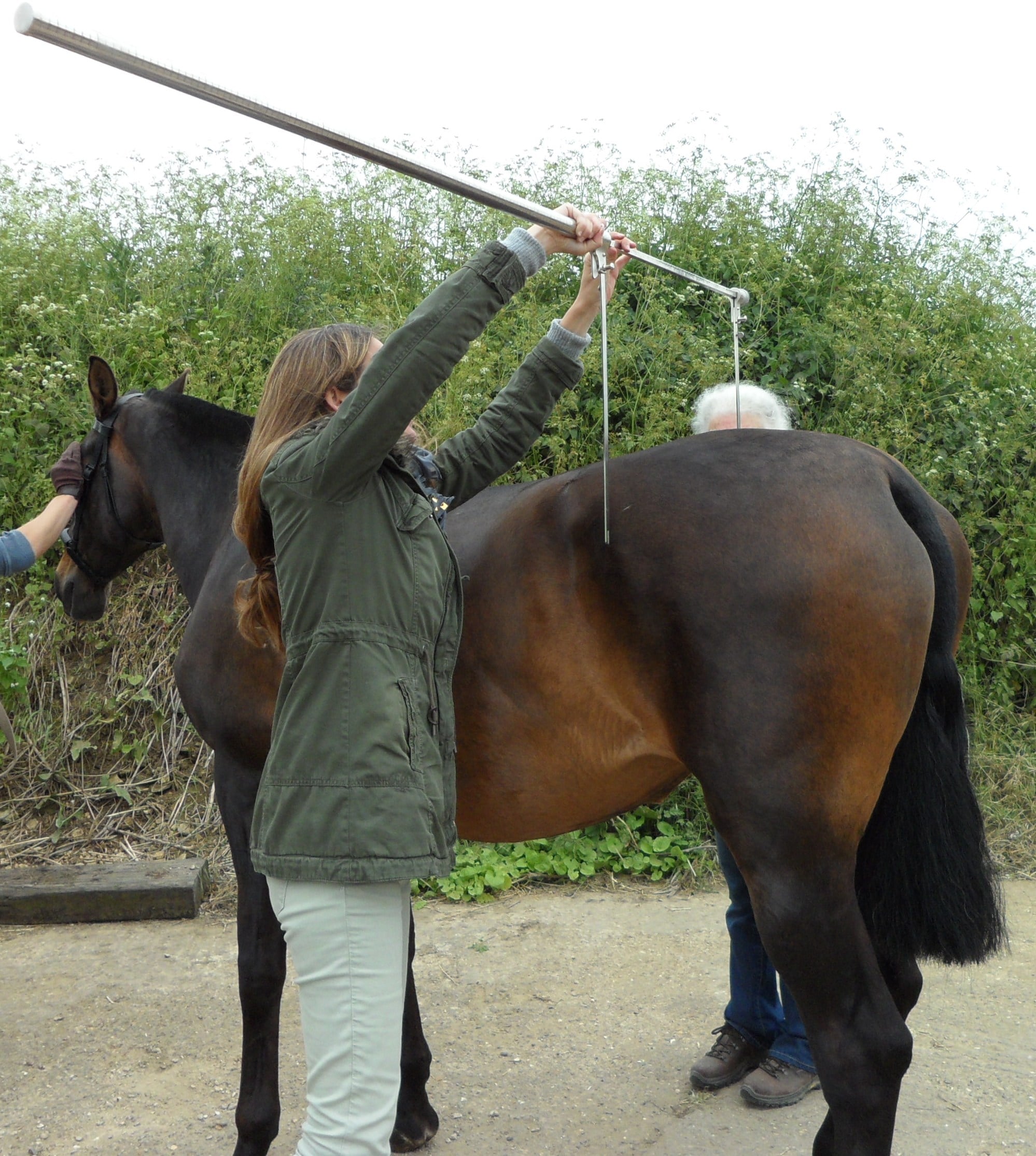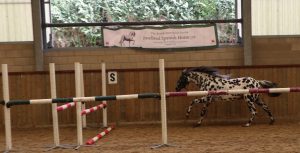Breeding Approval & Grading for Stallions & Mares In PFH, SSSH, SNH, & AAH Studbooks
BREEDING APPROVAL & GRADING APPLICATION FORMS 2023
PFH, HA, SSSH, SNH, AAH STALLIONS Breeding Approval STAGE 1 Reproductive Exam by Vet – 2023
SECTION 1B MEASUREMENTS DOCUMENT FOR VIRTUAL GRADING – 2023
Fill In ALL of This Form With Your Horse’s Conformation Measurements
INFORMATION & PROCEDURES DOCUMENT FOR THE VIRTUAL GRADING
2023 VIRTUAL GRADING EVENT – DETAILS & PROCEDURES
READ This 10 page Document Thoroughly from Start to Finish and then Start on Your Horse’s Virtual Grading Submission
******************************
2021 VIRTUAL GRADING – GOLD AWARD STALLIONS
Two 2021 PFH Stallions achieved GOLD AWARD Breeding Approval

Left; HSF Ultimates Blue (RMH) and Right; Ciclon Marismeño
Two 2021 SSSH Stallions achieved GOLD AWARD Breeding Approval

Left; Aztecs Quetzalcoatl and Right; Aztecs Ozomatli
2019 GRADING
ORV BANDIT – Gold Award Breeding Approval.
3 years old, 1.58m, Grey (dark Bay) Stallion – pictured with his breeder, Jennifer Thomson and her partner Kyle.
First ‘PRE Fusion Horse’ Stallion to be Approved For Breeding under the new DEFRA certified PRE Fusion Horse (PFH) Breeding Programme.

ORV BANDIT – flying down the jumping lane
2023 GRADING IS VIRTUAL AGAIN THIS YEAR AS IT WAS SO SUCCESSFUL IN 2022 & 2021. There will be TWO Virtual Grading Sessions for PRE Fusion Horses (PFH), Hispano-Arabs (HA), Spanish-Norman Horses (SNH), Spanish Spotted Saddle Horses (SSSH), and Albion Aztecas (AAH) during 2023.
The first Virtual Grading Session will run from 1st MAY to 30th MAY – Application forms, Stallion Stage 1 Reproductive forms and fees must be at BAPSH Ltd by or before 1st MAY. Grading Submissions with photos, videos, and measurements must be received by or before 30th MAY.
The second Virtual Grading Session will run from 1st SEPTEMBER to 30th SEPTEMBER – Application forms, Stallion Stage 1 Reproductive forms and fees must be at BAPSH Ltd by or before 1st SEPTEMBER. Grading Submissions with photos, videos and measurements must be received by or before 30th SEPTEMBER.
Owners have the amazing opportunity to present their Brood Mares, and youngsters aged 3yrs or over for Evaluation and Breeding Approval (Grading) without the need to travel to a central venue.
BAPSH hope that all horse breeders/ owners who don’t want to travel their horses will take advantage of this opportunity to Grade your horses from ‘home’.
Grading Stage 2 Entry Forms and Instructions on the Virtual Grading procedure are going to be available by end of February and will be at Top of the Page.
All Stallions MUST still have completed the Stage 1 Reproductive Assessment by an Equine Vet – see Information in ‘INTRODUCTION TO GRADING YOUR HORSE…’
TO APPLY For BREEDING APPROVAL in 2023 – Download the Stage 1 & Stage 2 Application forms for Stallions, and just the Stage 2 Application form for Mares + DNA sample if required – SEE DETAILED INSTRUCTIONS FURTHER DOWN THE PAGE.
Stage 1 Grading Fee is paid directly to the Vet practice performing the Reproductive assessment for Stallions.
Stage 2 Grading Fee is £100.00 to be Paid with the Application Form/s to reach BAPSH by or before ONE of these Dates:-
EITHER
1st MAY 2023 – If you plan to send BAPSH your Horse’s Virtual Grading Submission by 30th MAY
OR
1st SEPTEMBER 2023 – If you plan to send BAPSH your Horse’s Virtual Grading Submission by 30th SEPTEMBER
(by the Post Mark or Bank Transfer date) by Cheque paid to BAPSH Ltd OR by BANK TRANSFER – see details on the Stage 2 Application form)
SEND ALL Application FORMS & FEES to the REGISTRAR by or before 1st MAY or 1st SEPTEMBER 2023. Upon receipt the Registrar will confirm the acceptance of your mare or stallion for the Virtual Grading.
BAPSH Registrar – Holly Trees Farm, Chesterblade Road, Stoney Stratton, Shepton Mallet, Somerset, BA4 4EQ. Email:- bapshregistrar@btinternet.com
Owners of Stallions Standing at Stud for 2023 & Mares who may be too heavy in foal by September are advised to submit their Horse’s Grading Presentation for May early Evaluation and Grading
Owners of Horses that need a Spring and summer of maturing and training are recommended, or whose mares are foaling in Spring are recommended to apply for the Autumn Virtual Grading
******************************************************************************************
INTRODUCTION TO GRADING YOUR HORSE FOR BREEDING APPROVAL
Breeding Approval evaluation for Stallions registered in the above Studbooks consist of Two Stages, Stage 1 – the Veterinary Reproductive Examination, & Stage 2 – Grading, normally at the central venue but this year from their homes, + DNA Typing (if not already completed) + certified freedom from the relevant genetic diseases.
Breeding Approval evaluation for Mares registered in the above Studbooks consists of Stage 2 – Grading, normally at the central venue but this year from their homes, + DNA Typing (if not already completed) + certified freedom from the relevant genetic diseases.
Stage 1– The Veterinary Reproductive Examination for Stallions. This examines the horse for the presence/absence of undesirable inheritable traits and this must be completed before 1st MAY or 1st SEPTEMBER 2023 in order to enter Stage 2.
The Owner requests the PFH, HA, SSSH, SNH, AAH Breeding Approval Reproductive Examination Form from the BAPSH Registry Office, or Downloads the document from the link at the Top of the Page, and books a visit from an experienced Equine Vet from their own Vet Practice. The Fee for the Examination is paid direct to the Vet Practice and equates to the cost of a standard 2-Stage Vetting with an average cost of £125.00 + VAT.
A 30 to 40 strand Hair Sample is pulled from the horse’s mane by the Vet at the end of the Examination and placed in the DNA Sample Envelope (stamped & signed by the Vet) to be sent to BAPSH Ltd with the completed Reproductive Examination Certificate, the £26.50 fee for DNA Typing if the horse does not yet have a DNA-Type recorded with BAPSH, and the BAPSH Ltd Studbook Breeds Stage 2 Grading Application form and the £100.00 fee for Stage 2.
Stage 2 – Grading. This consists of Measurements, Conformation & Type, Movement in-hand and loose, and loose Jumping
The EXACT DETAILS for the 2023 Virtual Grading can be read on this Document with Photos showing how to take each Measurement and advice on training and procedures and equipment – 2023 VIRTUAL GRADING EVENT – DETAILS & PROCEDURES
The Grading Evaluations will be done as soon as possible AFTER the Closing Date of 3oth MAY or 30th SEPTEMBER 2023 from the submitted information, photos and video-clips, by the Directors of the BAPSH Studbook who each have over 30 years experience in breeding and assessing PRE breeds and blends.
GRADING SUBMISSIONS THAT DO NOT CONTAIN ALL OF THE REQUIRED MEASUREMENTS, PHOTOS, AND MOVEMENT & JUMPING VIDEO-CLIPS WILL NOT BE ASSESSED UNLESS THE OWNER SUBMITS THE MISSING SECTIONS WITHIN ONE WEEK.
The Overall Grading result is scored out of 100
Horses must score a minimum score of 50/100 for all parts of the assessment to be Approved for Breeding.
Horses with an average score of 60/100 across the assessment are recognised with the Bronze Award Breeding Approval.
Horses with an average score of 70/100 across the assessment are recognised with the Silver Award Breeding Approval.
Horses with an average score of 80/100 or above across the assessment are recognised with the Gold Award Breeding Approval
All the data for each horse is recorded on the BAPSH Studbook. The information gathered is used to monitor the development of each breed and to assist breeders to make informed choices when planning their stud-farm breeding programmes.
Requirements To Meet For Acceptance to Apply for the GRADING
1.Horses must have reached their 3rd Birthday or be older, so all horses born on/before 01/05/2020 for the May session or born on/before 01/09/2020 for the August session are eligible.
2.The horse must be registered with BAPSH Ltd & owned by the person recorded in the BAPSH National Studbook and in the Passport for the horse.
3a. The horse must already have a DNA Type/profile completed, or a DNA sample must be submitted to the BAPSH Registry Office with the application for Stage 2 Grading.
3b. The horse must be certified Negative for the genetic diseases which may affect one of the purebreeds which contribute to the foundation of the Studbook. The relevant Certificate/s for the horse or it’s ancestor must be at BAPSH Registry Office.
4.Stallions must have passed Stage 1 – The Veterinary Reproductive Examination, and the Certificate must have been submitted and accepted by the BAPSH Registry Office.
5.The Grading Stage 2 Booking Application Form and the Fee have been received.
PREPARING YOUR HORSE FOR GRADING
PRESENTATION
General – Your horse should be clean BUT NOT COVERED IN SHOWSHEEN or similar product! It is difficult to measure a very slippery horse !!
Manes and Tails -This is a matter of personal choice for Owners, who can choose between Plaited mane & tail or Loose mane & tail. The decision should be based upon producing the best look for a particular mare or stallion; some look better plaited up, others look better with loose flowing hair. 
‘Loose mane and tail’ – demonstrated by the PRE Fusion Horse mare, Mistrasl Snow Fire, above left, also wearing a smart leather Headcollar with long leadline.

‘Plaited’ – demonstrated by 3yr old Spanish-Norman Horse at a County Show (Note:- a bridle with bit is not used for Grading Events).
Alternatively, Mares of all 4 breeds may be presented with manes and tails clipped in the traditional manner for PRE Mares as shown below by these two beautifully prepared traditionally clipped UK mares.


Hairy Fetlocks & Heels – should be neatly Trimmed. Long tufty hair sticking out of the ears should be trimmed short level with the ear edge, and any long winter hairs left on the jaw line should be removed .
Feeler whiskers do NOT need to be trimmed off – they are important to a horse’s sensory input.
Hooves should be well shaped, and may be grown a little longer and deeper if there might be a height issue for your horse (check your Breed Standard). You may also present a horse fully shod or shod in front only. Extra thick shoes are not acceptable and will be deducted from the wither measurement. It is preferable NOT to oil your horse’s feet.
Horse head-gear
Mares should be presented wearing a suitable strong Headcollar /Halter with a fixed ring attachment for the lead rope that gives good control or a Spanish Serreta as demonstrated by the the mare on the left. Do NOT use any form of rope halter.
Stallions should be presented in a Spanish Serreta, or similar head-gear with a fitted & fixed Non-tightening Noseband, with a long leadline attached.
 Spanish-Norman Horse Stallion, Silversons Winchester, presented in a nicely fitted serreta.
Spanish-Norman Horse Stallion, Silversons Winchester, presented in a nicely fitted serreta.
Do Not use a show halter with a chain under the jaw – these destroy the correct outline of any horse and will have a Negative effect on your horse’s Grading. You will need a 20ft Lunge line to clip to your horse’s headgear for the Movement Section plus a lunge whip or similar.
Handlers – Please wear smart but sensible clothes yourself – you are being filmed for posterity and thus representing the UK breeders/owners of your respective Breeds. BAPSH recommends that both male and female handlers wear smart but comfortable trousers, and jackets that do NOT flap about in the wind or when you are moving. Footwear should be sturdy and easy to run in.
TRAINING YOUR HORSE
NOTE: the 2023 VIRTUAL GRADING has required some Changes to the Information below so that it is easier for Owners to enter the 2023 VIRTUAL GRADING.
Read this Document for the variations in Training Requirements for 2023 and to see the Measurement Photos on pages 2 to 6 – 2023 VIRTUAL GRADING EVENT – DETAILS & PROCEDURES
It is IMPORTANT to give your Horse every advantage for the Grading by presenting your horse in good condition, nicely muscled with a smooth covering of fat to give the typical firmly rounded outline that we love in our five Breeds based upon the PRE horse. Good manners and good behaviour are also very important – any horse behaving badly/dangerously can be dismissed un-graded by the Directors.
There are 3 sections for which you need to train your horse. NB This is the usual order but Sections b & c can be completed first if preferred by the handler/owner.
a)MEASUREMENT, CONFORMATION & TYPE SECTION
The PFH, HA, SSSH, SNH, and AAH Horses will normally have a similar sequence of measurements as the Purebred Spanish Horses, but for the Virtual Grading some of the less important measurements have been removed from the requirements. BAPSH want to build up a database of dimensions that are typical for each breed.
Please check the individual Breed Standards on our website for the normal height range etc.
Look at the sequence of ‘How to do the Measurement’ Photos on Pages 2 to 6 of the 2023 Virtual Grading Event Details and Procedures to see the measurements that you and your horse need to be familiar with before you get to work measuring.
Your horse must be trained to stand quietly and calmly for around 30 minutes whilst you complete this section and it may be easier with a helper if possible.
The measuring with a long stick can be a bit unnerving for a horse if you haven’t practised measuring it with a stick, so it is very important that you spend time accustoming your horse to having a solid stick placed all around his/her body, head, and neck. I suggest that you start your training with a short piece of lightweight wood, eg., dowelling, and progress to longer pieces as your horse’s confidence grows.
BAPSH expect the horse being assessed for conformation type and measurements to stand quietly and calmly whilst being looked at and measured. Any horse that cannot be measured will not be assessed and have to come back another time with a brand new application and full fee.
Here are the measurements that will be made and a description of where they are taken to and from on the horse
Height at the top of withers: Measured from the highest point of the withers vertically down to the ground where the horse is standing.
Height at base of withers: Measured from the lowest point of the withers vertically down to the ground where the horse is standing.
- Height at point of croup: Measured from the highest point at the croup vertically down to the ground where the horse is standing.
- Scapular-isquial length: Horizontal distance from the point of shoulder to the point of buttocks (ischial prominence).
- Length of head: Length of the straight segment between the highest point of the poll and the edge of the upper lip.
Length of mouth: - Width of head: Length of the straight segment between the most laterally extended points of the zygomatic arches. (Tape measure)
- Length of neck: Length of the straight segment between the scapular spine (shoulder-blade) and the base of the ear.
- Width of breast: Distance across the front of the breast between the points of shoulder.
- Length of shoulder: Straight distance along the shoulder-blade from the highest point of the withers to the point of shoulder
- Length of upper-arm: Straight distance from the point of shoulder to the point of the elbow.
- Length of forearm: Vertical straight distance between the line, parallel to the ground, traced from the elbow down to the middle of the carpal joint (at accessory bone level).
- Width of croup: Horizontal distance between the most lateral and caudal points of the tuber coxae. (the widest distance between the outer edges of the hipbones)
- Length of croup: Horizontal distance between the most cranial point of the tuber coxae and the most caudal of the tuber ischii. (ie. From the point of the hipbone nearest the head to the bit of the ischial prominence farthest away)
- Buttock-stifle distance: Distance between the ventral point of the tuber ischii (underside of the point of buttock) and the stifle.
- Length of gaskin: Distance between the stifle and the point of hock.
- Thoracic perimeter: The reference points are the lowest point of the withers and the sternum along the plane immediately behind the elbow, ie circumference of the horse around girth area – this is measured with a flexible tape measure.
- Perimeter of knee: Maximum perimeter of the transversal plane of the carpal bone.
- Perimeter of anterior cannon bone: Perimeter of the upper third of the metacarpal region.
- Angle of shoulder: Angle formed by the line of the length of the shoulder with the horizontal.
- Angle of croup: Angle formed by the line of the length of the croup with the horizontal.
- Proportionality index: Quotient between the height at the withers and the scapular-ischial length multiplied by 100 . This is a mathematical calculation taken from the previous measurements.
b)MOVEMENT SECTION
The Movement Section for the Grading process comprises walk, trot, and canter. It is VERY important to spend plenty of time practising with your horse in order to do this section as well as possible as a significant number of points come from the movement section.
The Directors will be looking for the following:-
1.Walk in a straight line showing a four-beat walk that is active and tracks up well, PREFERABLY OVERTRACKING
2.Trot in a straight line showing good elevation, flexion, extension, and drive, and tracking up correctly, over tracking better. Some horses work better on a large circle so you will also be asked show your horse at the trot for 3 or 4 circuits on the lunge line.
3.Canter on a lunge line in a circle – 3 or 4 well balanced circuits, ideally performed in a calm, WELL-BALANCED, but energetic manner, rounded and uphill.
4.Loose Movement in all three paces should be filmed without handlers near the horse, but handlers may encourage the horse to move more energetically using plastic bags or stones shaken in a tin etc.
c) LOOSE JUMPING SECTION
This section is to assess attitude, willingness, general athleticism, and shape over the jumps. A sequence of 3 jumps are to be negotiated down a jumping lane within an arena or a section of a field; the distances between jumps will need to be adjusted to suit the proportions of the horse and it’s length of stride. The jumps should increase in height from the 1st to the 3rd. When you are training your horse for the videos, start with small jumps to begin with in order to encourage confidence and make sure you spend time getting the distances between the jumps correct for your horse to do well in the final submitted Videos.
Read the current information on Jumping in the 2023 Virtual Grading Procedures document.



VALLE ASOMBROSO – First Spanish Spotted Saddle Horse to be Approved For Breeding. This young Stallion loose jumped with great style and scope.
TO APPLY For BREEDING APPROVAL – Download the Stage 1 & Stage 2 Application forms for Stallions, and just the Stage 2 Application form for Mares. Follow the procedures on this page and then submit your Application Forms and Fees to :-
BAPSH Registrar – Holly Trees Farm, Chesterblade Road, Stoney Stratton, Shepton Mallet, Somerset, BA4 4EQ.
Cheques paid to BAPSH Ltd OR pay by BANK TRANSFER – see details on the Stage 2 Application form
Links to the Forms are available at the Top of The Page or from bapshregistrar@btinternet.com.
Stage 2 Grading Fee is £100.00 payable by/before 1st MAY OR 1st SEPTEMBER 2023 (by the Post Mark or Bank Transfer date)
SEND ALL FORMS & FEES TO THE REGISTRAR by/before 1st MAY OR 1st SEPTEMBER 2023 Upon receipt the Registrar will confirm the acceptance of your mare or stallion for the Virtual Grading.
If you have any queries then please email Mary McBryde, the BAPSH Ltd Registrar, at bapshregistrar@btinternet.com giving details of the query and a telephone number to call you back.
Please give a clearly identifiable SUBJECT in your email address box so that your email can be found if you get Spammed !!
Legendario – Approved For Breeding PRE Fusion Horse Stallion
